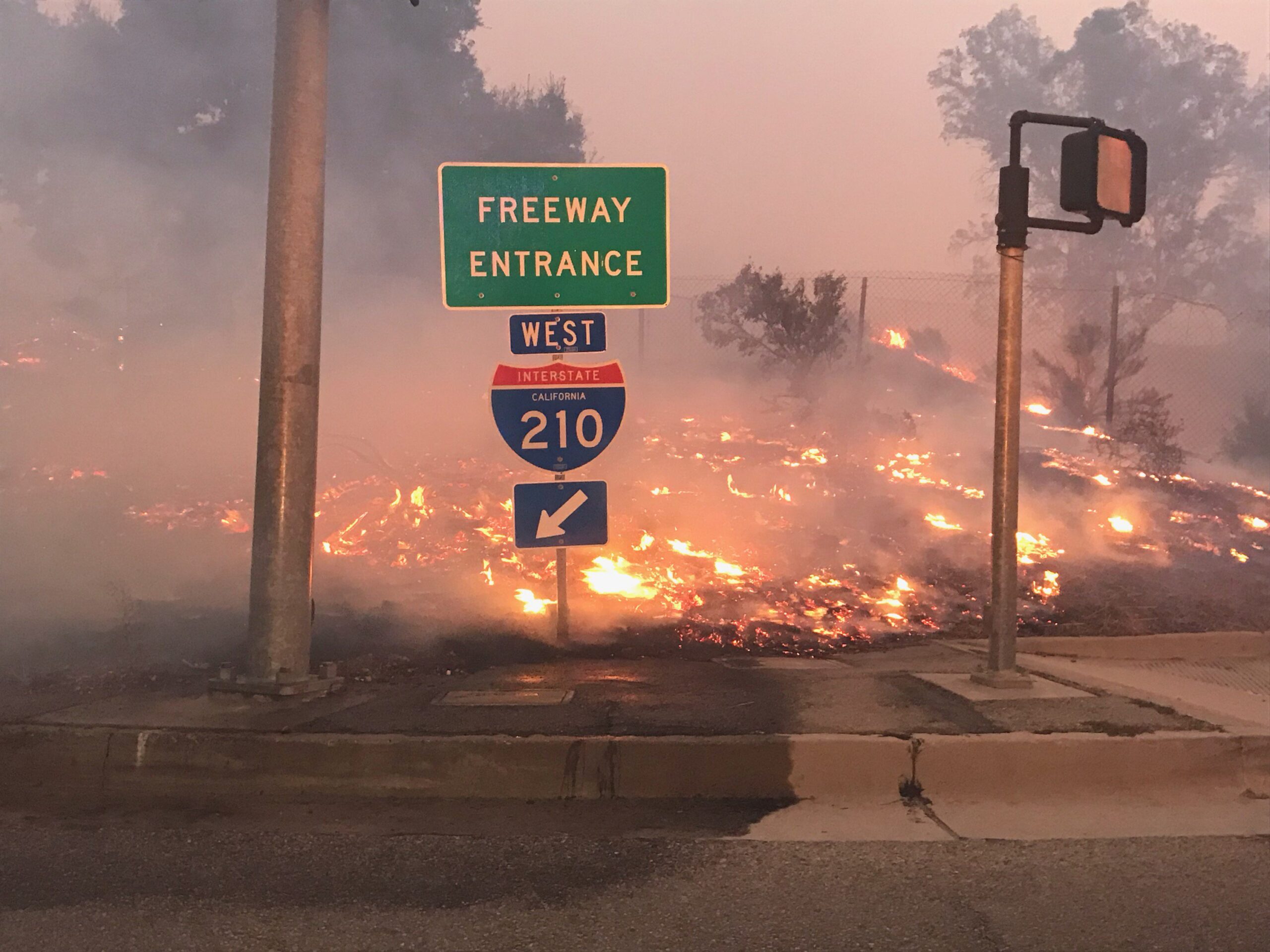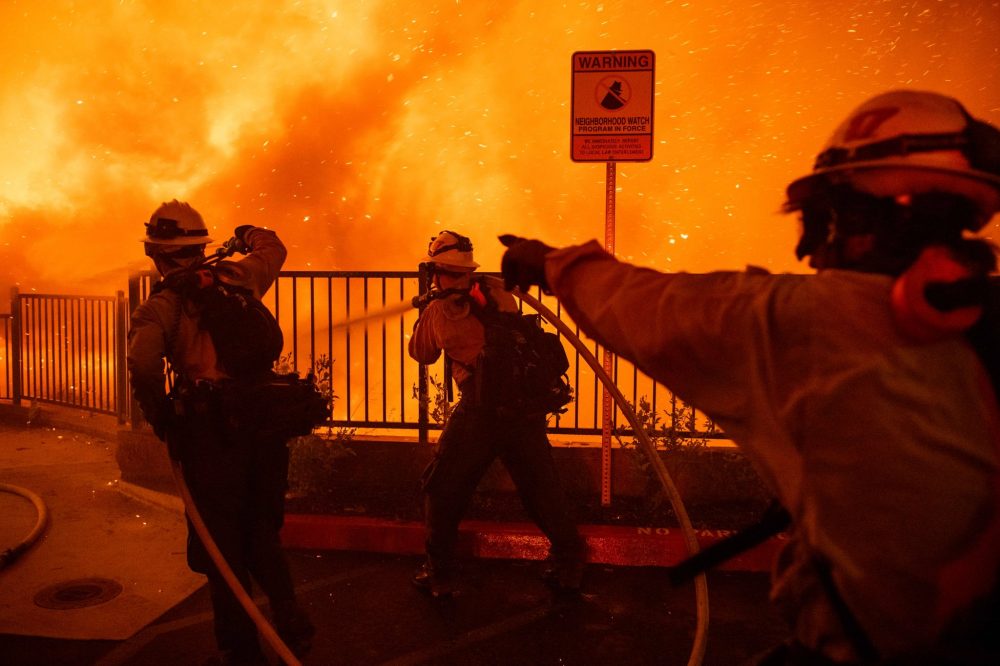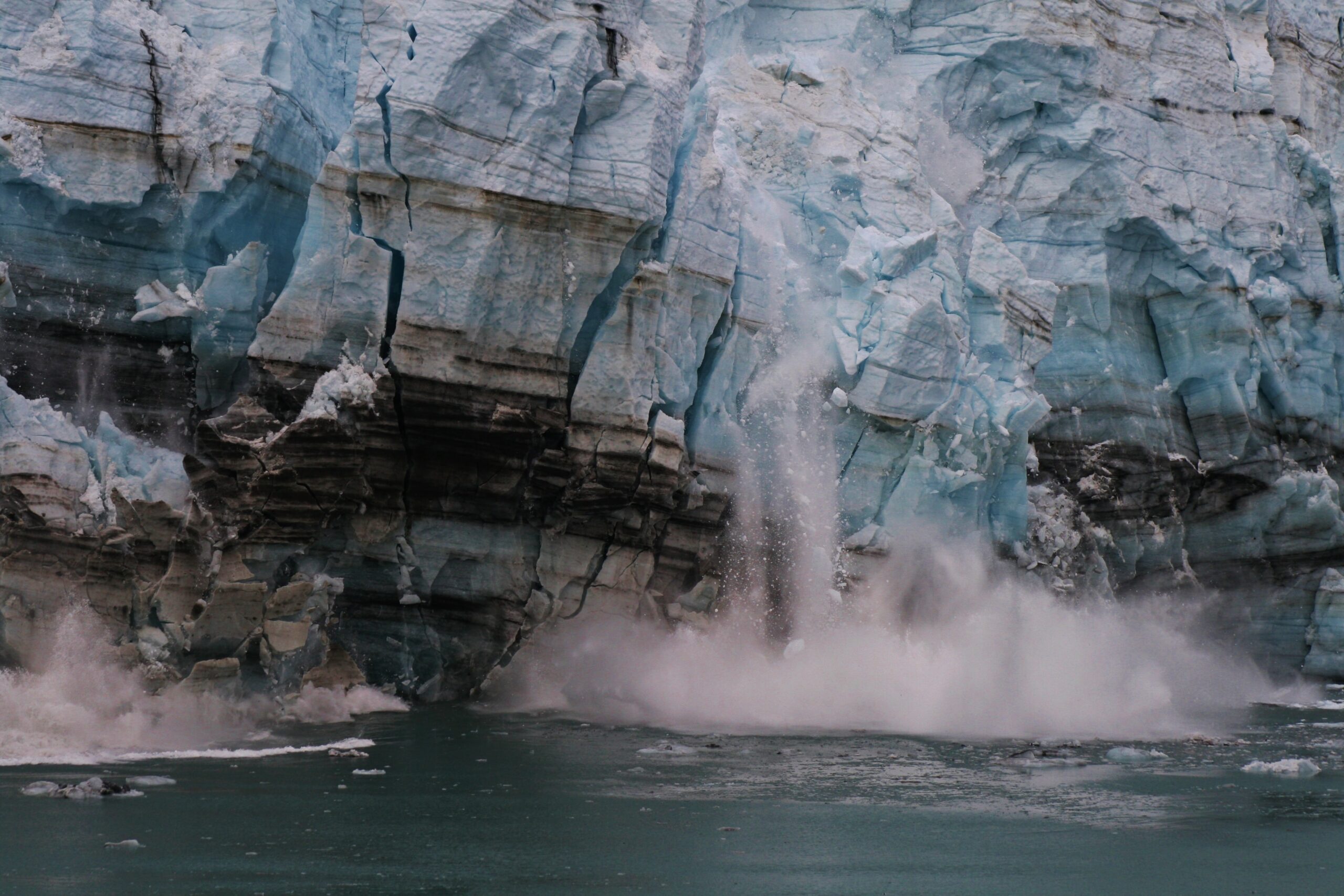
Last updated:
2019 California Wildfires

Overview
CalFire said in its 2019 Fire Season Outlook, “While wildfires are a natural part of California’s landscape, the fire season in California and across the West is starting earlier and ending later each year. Climate change is considered a key driver of this trend. Warmer spring and summer temperatures, reduced snowpack, and earlier spring snowmelt create longer and more intense dry seasons that increase moisture stress on vegetation and make forests more susceptible to severe wildfire. The length of fire season is estimated to have increased by 75 days across the Sierras and seems to correspond with an increase in the extent of forest fires across the state.”
(Photo source: Caltrans)
Various power companies including PG&E, Southern California Edison and San Diego Gas & Electric engaged in public safety power shut-offs (PSPS). These were aimed at preventing new fires from starting via a spark from a transmission line. However, power cuts also impacted schools, businesses and knocked out cell phone towers. The power cuts were particularly difficult on people with disabilities, especially those dependent on oxygen or other electrical-powered medical equipment (i.e. wheelchairs that need charging, feeding pumps). It also posed a challenge for the issuance of evacuation orders to communities without power as they may not have had access to the internet, a charged phone with data and/or TV or radio broadcasts.
Latest Updates

More Than $1 Million in Grants to Support Recovery from 2019 California Wildfires

What Paradise Has Lost
Overall 2019 wildfires impact
In 2019 there were 6,872 fire incidents in California, burning more than 253,321 acres (102,515 hectares) with 732 structures damaged or destroyed and three fatalities. This year’s fire season is over; any new fires that develop are likely to be small and easily controlled.
The Sandalwood Fire
The Sandalwood Fire was a wildland fire started by the dumping of burning trash by a garbage truck in the community of Calimesa in Riverside County. The fire began in the afternoon of Oct. 10, impacted 1,011 acres (409 hectares) before containment on Oct. 14. The fire damaged 16 structures and destroyed 74. Many of these structures were mobile homes in the Villa Calimesa mobile home park. Two people at the park died in the fire.
The Saddle Ridge Fire
The Saddle Ridge Fire was a brush fire that started in the evening of Oct. 10 in Los Angeles County beneath a high voltage transmission tower. It was extinguished on Oct. 31 after it had burned 8,799 acres (3,561). It led to eight injuries of first responders or civilians, as well as a civilian fatality. At least 88 structures were damaged and 19 were completely destroyed.
The Kincade Fire
The Kincade Fire was a vegetation fire in Sonoma County that started on the evening of Oct. 23. It burned 77,758 acres (31,468 hectares) before it was contained on Nov. 6. At least 374 structures including 174 homes were destroyed; 60 structures including 34 homes were damaged. In addition, there were four injuries of first responders.
The Tick Fire
The Tick Fire was a brush fire in Agua Dulce in Los Angeles County that started on the afternoon of Oct. 24. When it was contained a week later on Oct. 31, it had burned 4,615 acres (1,868 hectares). Twenty-two structures were destroyed and 27 were damaged.
The Getty Fire
The Getty Fire was a fire in Los Angeles County that started on Oct. 28. As of Nov. 5, it had burned 745 acres (310 hectares) and had 100 percent containment. The cause of the fire has been determined to be accidental. It started when high winds broke a tree branch and sent it into power lines, creating sparks. Ten residences were destroyed and 15 were damaged. There were five firefighter injuries.
The Maria Fire
The Maria Fire was a fast-moving brush fire in Ventura County that started on Oct. 31 and grew to over 8,000 acres (3,237 hectares) in less than 24 hours. It was contained fairly quickly after burning 9,999 acres (4,046 hectares). Four structures were destroyed.
- Recovery needs for each wildfire area vary, but attention should be given to long-term support for rehousing, income recovery and agricultural needs.
- In the off-season, attention should be paid to additional preparedness measures to support vulnerable populations, especially those living with disabilities, people who are undocumented, and people who do not speak English.
- Due to the annual risk of wildfires, the need for immediate and ongoing mental health support and counseling services are significant.
- As with most disasters, cash donations are recommended by disaster experts. Cash allows on-the-ground agencies to direct funds to the greatest area of need, support economic recovery, and ensure donation management does not detract from disaster recovery needs.

In response to the fires, the Center for Disaster Philanthropy (CDP) launched the 2019 California Wildfires Recovery Fund to support medium- and long-term recovery.
Contact CDP
Recovery updates
If you are a responding NGO or a donor, please send updates on how you are working on recovery from this disaster to Tanya Gulliver-Garcia.
Donor recommendations
If you are a donor looking for recommendations on how to help with disaster recovery, please email Regine A. Webster.
Philanthropic and government support
CDP awarded over $1 million through six grants from the 2019 California Wildfires Recovery Fund:
- Community Foundation Sonoma County received $250,000 to support ongoing disaster case management through the Kincade Wildfire Recovery Project. The project provides financial assistance to low-income Sonoma County households greatly affected by the Kincade Fire. Through a partnership with Community Foundation Sonoma County, this grant will also support UndocuFund and Catholic Charities of the Diocese of Santa Rosa.
- Community Action Partnership of Sonoma County on behalf of Rebuilding Our Community Sonoma County (ROC) was awarded $100,000 to shore up and extend ROC’s operations and their resource center, enabling them to continue to serve Sonoma County residents who have been directly impacted by the Kincade Fire. By strengthening the principle hub for Kincade Fire recovery coordination, the grant supports the work of other fund grantees who currently use the ROC resource center to collaborate and coordinate support for fire survivors.
- Corazón Healdsburg received $250,000 for their Corazón Healdsburg Unity and Community Fund for Kincade Fire Victims, a program which supports the most vulnerable individuals and families affected by the Kincade Fire. The program provides direct financial assistance to cover expenses such as utility bills, food, medical care, shelter, repairs, transportation and other urgent unmet needs.
- Latino Service Providers (LSP) received $100,000 for their LSP Youth Promotores program. The program seeks to counteract the stigma associated with addressing mental health issues. By engaging and educating the Latinx community on mental health and disaster preparedness issues, the program helps survivors access culturally appropriate mental health resources and create emergency preparedness plans.
- United Policyholders received $100,000 for the 2019 Southern California Wildfires Roadmap to Recovery Program. The program provides pro bono legal services for disaster survivors to help them secure and maintain housing post-disaster through advocacy and education related to insurance claims.
- United Way of the Wine Country was awarded $250,000 to continue providing financial assistance through disaster case management to Kincade Fire survivors. The grant will allow United Way to fill the unmet rebuilding needs of those who lost their homes in the fire.
On Oct. 27, Gov. Gavin Newsom issued a state-wide declaration of emergency in response to the fires. He had previously issued declarations on Oct. 11 for Los Angeles and Riverside counties due to the impacts of several fires including the Saddle Ridge, Sandalwood, Reche, Wolf and Eagle fires, and on Oct. 25 for Los Angeles and Sonoma counties because of the Kincaide and Tick fires. The state secured several Fire Management Assistance Grants (FMAG) to support 75 percent of certain firefighting costs for several fires.
On Oct. 25, Gov. Gavin Newsom launched a $75 million Local Government PSPS Resiliency Program in response to the public safety power shutoffs that utility companies initiated to try to prevent fires from starting. The goal of the program is to “mitigate the impact on Californians by supporting continuity of operations and efforts to protect public health, safety, and commerce in affected communities.”
On Dec. 23, the governor also issued a proclamation extending the state’s prohibition against price gouging until Dec. 31, 2020 in several communities affected by fires that occurred between 2017 and 2019.
Resources

Wildfires
Weather can significantly affect the frequency and severity of wildfires. Prolonged drought can extend prime wildfire season, making blazes more likely. Additionally, high temperatures and low humidity can quickly dry out vegetation which then becomes potential fuel.

Climate Change
Climate change refers to any significant change in the measures of climate lasting for an extended period of time. In other words, climate change includes major changes in temperature, precipitation or wind patterns, among other effects, that occur over several decades or longer.

Is your community prepared for a disaster?
Explore the Disaster Playbook